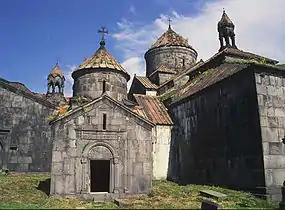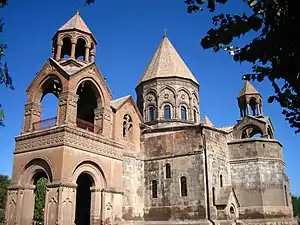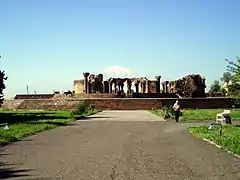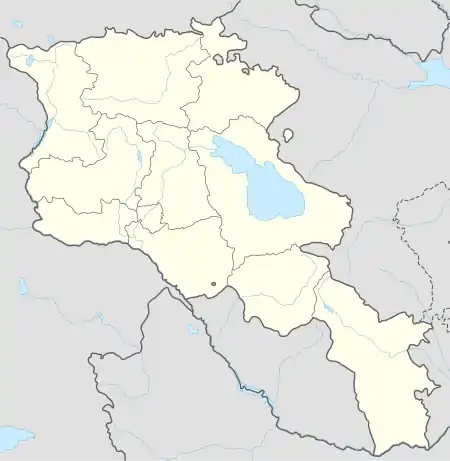List of World Heritage Sites in Armenia
The United Nations Educational, Scientific and Cultural Organization (UNESCO) World Heritage Sites are places of importance to cultural or natural heritage as described in the UNESCO World Heritage Convention, established in 1972.[1] Following the breakup of Soviet Union, Armenia succeeded the convention on 5 September 1993.[2]
As of 2018, Armenia has three sites on the list, with additional four on the tentative list (the official list of sites that may be considered for future submission). All three sites on the list are listed as cultural sites, as determined by the organization's selection criteria.[3]
World Heritage Sites
UNESCO lists sites under ten criteria; each entry must meet at least one of the criteria. Criteria i through vi are cultural, whereas vii through x are natural.[4]
| Site | Image | Location | Year listed | UNESCO data | Description |
|---|---|---|---|---|---|
| Monasteries of Haghpat and Sanahin |   |
Villages of Haghpat and Sanahin, Lori Region | 1996 | 777; ii, iv (cultural) | These two monasteries in the Tumanian region from the period of prosperity during the Kiurikian dynasty (10th to 13th century) were important centres of learning. Sanahin was renowned for its school of illuminators and calligraphers. The two monastic complexes represent the highest flowering of Armenian religious architecture, whose unique style developed from a blending of elements of Byzantine ecclesiastical architecture and the traditional vernacular architecture of the Caucasian region.[5] |
| Cathedral and Churches of Echmiatsin and the Archaeological Site of Zvartnots |   |
Armavir Region | 2000 | 1011; ii, iii (cultural) | The cathedral and churches of Echmiatsin and the archaeological remains at Zvartnots graphically illustrate the evolution and development of the Armenian central-domed cross-hall type of church, which exerted a profound influence on architectural and artistic development in the region.[6] |
| Monastery of Geghard and the Upper Azat Valley |   |
Kotayk Region, near the village of Goght | 2000 | 960; ii (cultural) | The monastery of Geghard contains a number of churches and tombs, most of them cut into the rock, which illustrate the very peak of Armenian medieval architecture. The complex of medieval buildings is set into a landscape of great natural beauty, surrounded by towering cliffs at the entrance to the Azat Valley.[7] |
Tentative list
- The archaeological site of the city of Dvin (1995)
- The basilica and archaeological site of Yererouk (1995)
- The monastery of Noravank and the upper Amaghou Valley (1996)
- The monasteries of Tatev and Tatevi Anapat and the adjacent areas of the Vorotan Valley (1995)
See also
- Armenia and the United Nations
- List of World Heritage Sites in Europe
- Tourism in Armenia
References
- "The World Heritage Convention". UNESCO. Archived from the original on 1 April 2016.
- https://whc.unesco.org/en/statesparties/am
- https://whc.unesco.org/en/statesparties/am
- "UNESCO World Heritage Centre – The Criteria for Selection". UNESCO World Heritage Centre. Archived from the original on 12 June 2016. Retrieved 17 August 2018.
- https://whc.unesco.org/en/list/777
- https://whc.unesco.org/en/list/1011
- https://whc.unesco.org/en/list/960


